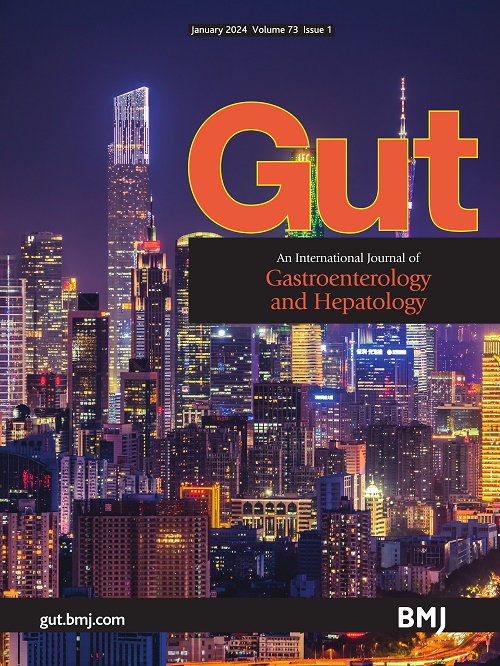在一项研究者发起的介入性试验中,hbv特异性t细胞受体- t细胞疗法(SCG101)治疗hbv相关肝细胞癌患者的临床结果
IF 25.8
1区 医学
Q1 GASTROENTEROLOGY & HEPATOLOGY
引用次数: 0
摘要
背景:SCG101是一种特异性靶向乙型肝炎病毒(HBV)的自体t细胞疗法,使用一种稳定表达的天然高亲和力t细胞受体。在一项研究者发起的试验中,我们评估了SCG101在hbv相关肝细胞癌(HCC)患者中的安全性、药代动力学、药效学和疗效。设计6例人类白细胞抗原(HLA)-A*02:01阳性、血清乙型肝炎表面抗原(HBsAg)阳性和乙型肝炎e抗原阴性的晚期HBV-HCC患者,既往1- 3次全身治疗失败,在淋巴细胞清除后3天以5×107或1×108 TCR-T+细胞/kg的剂量接受SCG101治疗。结果:1周内,所有患者外周血T细胞扩增76±57倍,谷丙转氨酶明显升高。无神经毒性,但观察到细胞因子释放综合征达到3级。然而,这些副作用不受剂量限制,可以通过皮质类固醇、抗白细胞介素-6和/或血管加压治疗来控制。血清HBsAg水平在2周内下降了1.96 (0.16-3.84)log10,表明SCG101具有靶向活性。根据修订的实体肿瘤反应评价标准,6例患者中有3例实现肿瘤缩小,靶病变大小的最佳变化百分比分别为- 19.5%、- 74.6%和- 100%。一个显示目标病变完全缓解,保持无进展27个月,另一个实现了持久(60 - 6个月)缓解。随访期间(中位10.9个月),3例死亡,1例失访。结论:作为HBV-HCC患者的单药治疗,SCG101显示出明显的抗病毒和抗肿瘤活性,并且在支持治疗下安全性可控。SCG101的t细胞扩增、血清HBsAg下降和肿瘤反应共同强调了靶向活性。试验注册号[NCT05339321][1]。无数据。[1]: /查找/ external-ref ? link_type = CLINTRIALGOV&access_num = NCT05339321&atom = % 2 fgutjnl % 2恐惧% 2 f2025 % 2 f08 % 2 f12 % 2 fgutjnl - 2025 - 335456. -原子本文章由计算机程序翻译,如有差异,请以英文原文为准。
Clinical results of an HBV-specific T-cell receptor-T-cell therapy (SCG101) in patients with HBV-related hepatocellular carcinoma treated in an investigator-initiated, interventional trial
Background SCG101 is an autologous T-cell therapy specifically targeting hepatitis B virus (HBV) using a natural, high-affinity T-cell receptor that is stably expressed. Objective We evaluated the safety, pharmacokinetics, pharmacodynamics and efficacy of SCG101 in patients with HBV-related hepatocellular carcinoma (HCC) in an investigator-initiated trial. Design Six human leucocyte antigen (HLA)-A*02:01-positive, serum hepatitis B surface antigen (HBsAg)-positive and hepatitis B e antigen-negative patients with advanced HBV-HCC, who had failed one to three prior systemic therapies, received SCG101 at doses of 5×107 or 1×108 TCR-T+ cells/kg three days after lymphodepletion. Results Within 1 week, all patients experienced a significant but transient alanine aminotransferase elevation paralleled by a 76±57 fold expansion of T cells detected in peripheral blood. No neurotoxicity, but a cytokine release syndrome reaching up to grade 3 was observed. However, these side effects were not dose-limiting and could be managed with corticosteroids, anti-interleukin-6 and/or vasopressor therapy. Indicating on-target activity of SCG101, serum HBsAg levels dropped by 1.96 (0.16–3.84) log10 within 2 weeks. According to modified Response Evaluation Criteria in Solid Tumours, three of the six patients achieved tumour shrinkage with a best percentage change in target lesion size of −19.5%, −74.6% and −100%. One showed complete remission of the target lesion, remaining progression-free for 27 months and one other achieved a durable (>6 months) remission. During follow-up (median 10.9 months), three patients died, and one was lost to follow-up. Conclusion As monotherapy for patients with HBV-HCC, SCG101 demonstrated pronounced antiviral and antitumour activities and a safety profile manageable with supportive care. SCG101’s T-cell expansion, serum HBsAg drop and tumour response collectively underscore on-target activity. Trial registration number [NCT05339321][1]. No data are available. [1]: /lookup/external-ref?link_type=CLINTRIALGOV&access_num=NCT05339321&atom=%2Fgutjnl%2Fearly%2F2025%2F08%2F12%2Fgutjnl-2025-335456.atom
求助全文
通过发布文献求助,成功后即可免费获取论文全文。
去求助
来源期刊

Gut
医学-胃肠肝病学
CiteScore
45.70
自引率
2.40%
发文量
284
审稿时长
1.5 months
期刊介绍:
Gut is a renowned international journal specializing in gastroenterology and hepatology, known for its high-quality clinical research covering the alimentary tract, liver, biliary tree, and pancreas. It offers authoritative and current coverage across all aspects of gastroenterology and hepatology, featuring articles on emerging disease mechanisms and innovative diagnostic and therapeutic approaches authored by leading experts.
As the flagship journal of BMJ's gastroenterology portfolio, Gut is accompanied by two companion journals: Frontline Gastroenterology, focusing on education and practice-oriented papers, and BMJ Open Gastroenterology for open access original research.
 求助内容:
求助内容: 应助结果提醒方式:
应助结果提醒方式:


